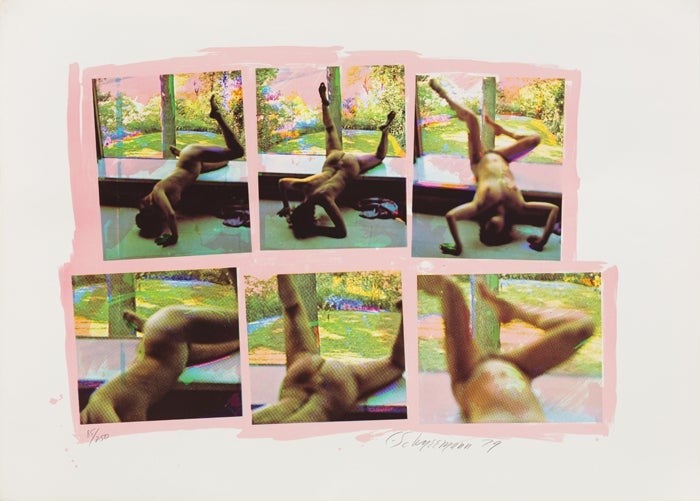CAROLEE SCHNEEMANN

Carolee Schneemann
Exhibition from Friday, September 13 to Saturday, November 9, 2019.
Opening on Thursday, September 12, 2019 from 6pm to 9pm.
At 7.30pm during the opening: conference by Émilie Bouvard, scientific directorof Giacometti Foundation.
Carolee Schneemann (1939-2019) was a painter… as well! Throughout her career, she constantly reminded us that performances, films, photographs, texts were works of painting to her. The striking omnipresence of the female nude throughout her work, often dealt with violently, was the better to elude the taboos of the time: “As a painter, I had never accepted the visual and tactile taboos surrounding specific parts of the body”. By
mistreating her body, Carolee Schneemann reclaimed it: far from the objectification of the female nude present in classical art, Schneemann’s body was a subject, suffering, living, at times sacrificed. She was a feminist trailblazer who used her body as a tool for advocacy, thereby distancing herself from the traditional representation of a model. The question Carolee Schneemann asks is whether the female body can be both an image and an image-maker, in a world where role models were scarce: « I decided a painter named ‘Cezanne’ would be my mascot: I would assume Cezanne was unquestionably a woman— after all the ‘anne’ in it was feminine. Were the bathers I studied in reproduction so awkward because painted by a woman? But ‘she’ was famous and respected. If Cezanne could do it, I could do it. »
As well as pushing the body beyond its limits, the images produced by Scheemann in her films, photographs or performances were later transformed or even destroyed through painting. Breaking with centuries of art history, her painting destroys the image rather than creating it. As such, she is positioning herself in the continuation of the abstract expressionist movement, using dripping techniques, amongst others, placing the artist’s painting body at the centre. However, this painting body – which also brings to mind Yves Klein – came to destroy or at the very least soil, deform, damage the very image of the body. This echo chamber of the image is the hallmark of her work.
Fuses, her iconic 1965 film in which she is seen in the sexual act through the placid eyes of her cat, was reworked in a rich variety of ways: the film is blown up, printed, painted, covered in acid, coloured. That work was the starting point for a series of ‘paintings’ created according to a recurrent principle that she established then: the images are juxtaposed to create a sort of narrative, then adapted, stuck back together and painted over. The narrative perspective aims to be neutral, without judgement. The action is seen from the perspective of her cat, who watches the artist and her partner of the time, James Tenney. She presents us with a free body, liberated from the taboos of her time. With this work, Carolee Schneemann broke the chains that bound the body, particularly the female body. Fuses is a central piece as it draws together all the themes found in Schneemann’s work. It is both a starting point and a manifesto.
The images that Carolee Schneemann used in her installations came only in part from the documentation of her performances. As the daughter of a doctor, of whom she said that he tended as much to living bodies as to dead ones, she used her own image as well as images from medical documentation.
In the series Hallucinating (2002) she also used war images, which she duplicated, cut up and stuck end to end, creating the impression of an explosion.
She also took images from pornographic films, such as in Ask The Goddess II (1988-2006) where a variety of visions of female and male genitalia from history, mythology and fiction sit side by side.
Following in the footsteps of Robert Rauschenberg, who she met while at the Judson Dance Theater, Carolee Schneemann assembled a variety of fragmented images, which she then coloured and marked with her body. Just as Fuses was a film that inspired her paintings, Devour/Goya (2006) was originally a video installation projected onto several screens, a collage of images that were then modified, using a variety of media that
respond to and complete each other.
Known as a performance artist, in her work Forbidden Actions-Museum (1979), Carolee Schneemann links performance to painting. She used the personal images that she painted, and which characterised her work, enlarged them and deformed them.
Carolee Schneemann’s adaptability to different surfaces means that her work retains the relevance of its beginnings: beyond her status as a feminist performance pioneer, she managed to break through to inspire our thinking on sequential narration, painting and cinema.